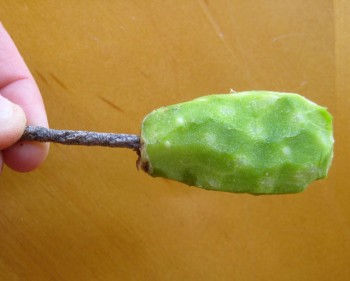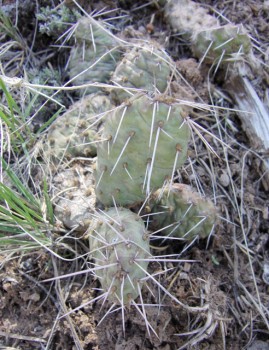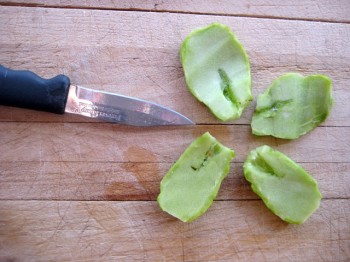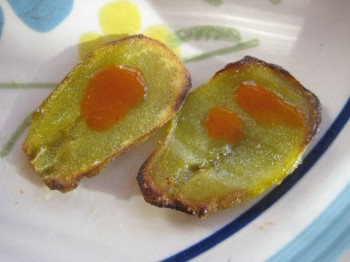
Apparently I’m not the only one to have gone about prickly pear cactus the wrong way the first time around. Allow me to relive that fateful day two years ago on a Malibu, California hillside where I endeavored to pick a plump prickly fruit bare-handed only to suffer the instant ejection by said fruit of 30 or so its tiny, nearly invisible glochids into my fingers, after which I made matters worse by trying to pull them out with my teeth and ended up with lips and tongue laden with the pointy buggers.
The glochids are the prickly pear’s secret weapons, for the perennial succulent also hosts larger, more apparent spines meant entirely to deceive you. You’re a sucker if you grab a piece by a supposed non-spiny section because meanwhile the cactus is spearing your unwitting hands 30 times over—or mouth and throat, as in the case of Sam Thayer, who describes his first childhood bite-and-swallow of a glochid-covered prickly pad in Nature’s Garden (2010). Still, Sam did not let it spoil a fabulous weekend seeking snakes and turtles, and neither did I let it spoil my random hike through the Malibu nudist colony that day.
I learned my lesson, but it took two years to give the prickly pear (Opuntia sp.) another go. Fortunately I had the opportunity to collect some while visiting properties in Mesa, Colorado with outfitter Joe Keys. The Opuntia in Mesa are small and meager compared to those Malibu giants, but beggars can’t be choosers, and Joe was kind enough to spear two small but mature pads with his knife (as neither of us had gloves) before shoving a stick into the base of one and handing me the “cactusicle” to carry.

Fortunately cacti last a while in the fridge because it took two weeks and another unpleasant encounter with the glochids for me to finally get around to preparing and eating them.
Colorado Opuntia
I saw several different low-lying specimens that day in Mesa, but since Cattail Bob Seebeck (1998) indicates no look-alikes for the Rocky Mountain region’s Opuntia species, poisonous or otherwise, we decided to go for it. Joe sliced the pads at their joints, though I later read a recommendation by Carolyn Niethammer (2004) to cut the pad an inch above its base, leaving a stump for a new pad to grow.
Seebeck also notes that “Some larger prickly pear clumps may be over 100 years old” and recommends against harvesting from those.
The prickly pear cactus offers many edible products, the most well-known of which are the fruits, or prickly pears, themselves. I spent many years purchasing these plump purple fruits, called “tunas” in Spanish, from a Los Angeles farmers’ market. Inside, the seeds are tough but edible, “marginally chewable but hard enough to give your jaws a lot of exercise,” as Thayer puts it. I always ate them regardless, but some people prefer to scrape them out.

In terms of Colorado’s wild prickly pears, Seebeck indicates that “the really succulent, fruited species are found in the southern and eastern regions of the Rockies.”
Nopales Experiment
As April is not the time of year locally for fruits, I went for the pads instead. Known as “nopales” in Spanish, the mucilaginous cactus pads are popular south of the border and in the southern U.S., sold fresh with spines/glochids removed, or pickled in spicy vinegar. Much as I love Mexico and its cuisine, I spent years staring at this curious vegetable but only tried it recently when my local market put some big jars on sale.
I’ll say this: “mucilaginous” is an understatement. With each sliced nopal I forked, a long trail of clear slime came with it, from the jar all the way to the cutting board. They tasted like the Serrano peppers of the pickling mix. I ate most chopped and fried with eggs in breakfast burritos—good training, I think, for my first culinary experiment with wild prickly pear pads.
Glochid Battlefield
Cattail Bob says to burn off the big spines, so I tried this first. It smelled like burning hair and by the time I got to the end of the first tiny cactus pad, my lighter was red hot and burnt my fingers. Perhaps stirring them in some hot coals might have been a better approach.
Next I donned gloves and sliced off the outer layer, digging into the indented glochid-bearing areoles with my knife while trying to hold onto the increasingly slippery cactus pad with my “cactusicle” stick. Somehow I still managed to get glochids stuck in my fingers anyway.

No matter. After the work was done, I was proud of my sticky cactusicle and looking very much forward to eating it. Thayer says you can eat them raw but I decided to slice my nopales lengthwise to get two tiny “steaks” per pad. I sautéed them in oil until they were lightly browned and served them with salt and hot sauce, alongside eggs with wild greens potato pancakes.
The prickly pear pads came out juicy and crisped on the outside and slightly lemony.
It was a lot of work for the tiny treats, but I’ll do it again—especially if I come across a finer Opuntia specimen. I suppose next time I visit a California nudist colony I’ll have to bring gloves.
Udated 2.20.21

good post, i don’t know anyone who doesn’t get poked- even veteran eaters, but yes it’s worth it, and you usually learn to get very few pokes real quick… we like to fillet them and eat them raw, or roast them and mix with apple cider vinegar and hot peppers for a nopale hot sauce… don’tcha love th’ rockies, so many treats, so much sustenance
Our neighbor in Sedalia transplanted them to a huge flower bed just outside her basement window (walkout)for her jelly making purposes. As an added bonus they made a terrific theft detterent for would be burgulars.. lol